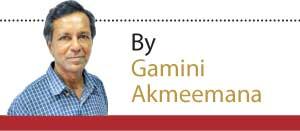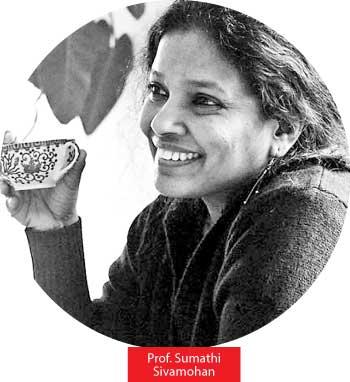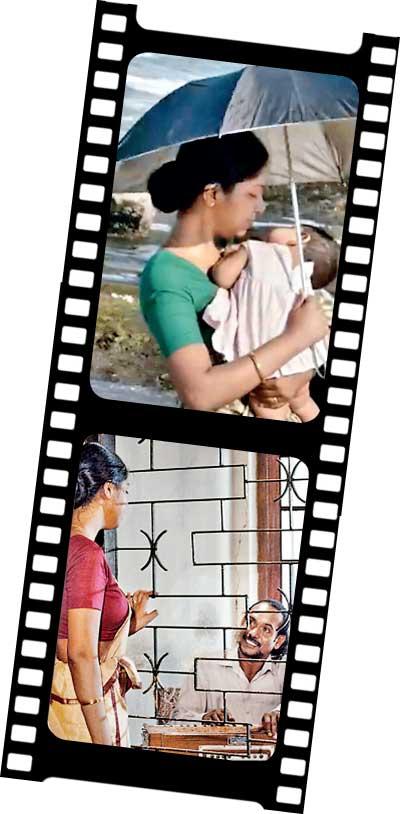Reply To:
Name - Reply Comment
“Fathers and Sons” by Prof. Sumathi Sivamohan is a very unusual movie. It is rich in texture, combining a fascinating mix of bleak storytelling counter-balanced by the  richness of its music and some of the visuals. Centred around the life of a Tamil musician and his Sinhalese wife and stepson, with anti-Tamil tensions and the July 1983 riots in the background, it portrays in no uncertain terms what it was like to be Tamil at the time.
richness of its music and some of the visuals. Centred around the life of a Tamil musician and his Sinhalese wife and stepson, with anti-Tamil tensions and the July 1983 riots in the background, it portrays in no uncertain terms what it was like to be Tamil at the time.
The riots are so compelling that they come to the foreground, poking the viewer in the eye.
It feels right that a Tamil filmmaker should tell this story. Not that the subject requires ethnic preference, but an equally serious attempt hasn’t been made by a Sinhalese filmmaker all this time.
The recent Ginnen Upan Seethala (A biopic about JVP leader Rohana Wijeweera) showed the riots (Mostly burning and looting in the background, leaving out the murder) and Jude Ratnam’s comprehensive work about the riots screened last year is
a documentary.
"The movie’s highs and lows are frustrating. Nonetheless, its unsentimental take on the racism, which runs like a cancer, not just through Lankan society but the music industry, too, is laudable."
“I didn’t want to make this a documentary,” Prof. Sivamohan says as the fine-tuned noises of nocturnal insect-life seep into the suburban living room we are sitting in.
She’s taken a break from her demanding job of teaching English at the University of Peradeniya. I ask her about the syllabus and she replies there are about 100 texts to be done within four years. As we talk, she tells me that Dr Rajini Thiranagama, Professor of Anatomy at the University of Jaffna murdered by the LTTE because of her dissenting views, was her sister.
 As such, she has a personal stake in the Sinhala-Tamil ethnic tragedy. She isn’t just a witness.
As such, she has a personal stake in the Sinhala-Tamil ethnic tragedy. She isn’t just a witness.
But, in telling this story from the other side, Prof. Sivamohan doesn’t lay it on too thick. She managed to make this sometimes searing, sometimes searching, sometimes lyrical and sometimes frustrating movie in nine days, with cinematography by Sunil Perera, music by Anthony Surendra and editing by veteran Elmo Halliday.
Veering away from the art house format, she stops short of the commercial one.
There are four songs in the film, with different moods. They are very much part of the narrative. Two are originals, one in Tamil and the other in Sinhala, both beautifully rendered. Prof. Sivamohan wrote the lyrics of one (in English), and the translated Sinhala version (By Prof. Liyanage Amarakeerthi) appears in the movie as Ko Mage Aloke (Sung by actress Bimsara Premaratne, who shows considerable singing talent). Anthony Surendra, in a rare film appearance, is shown singing at a recording session.
This movie has constantly shifting moods, from the whimsical and bleak to an occasional, almost maniacal high (For example when Niranjani Shanmugarajah dances at night on a beach to the tune of the 60s hit Bombay Meri Hai).
"In telling this story from the other side, Prof. Sivamohan doesn’t lay it on too thick. She managed to make this sometimes searing, sometimes searching, sometimes lyrical and sometimes frustrating movie in nine days, with cinematography by Sunil Perera, music by Anthony Surendra and editing by veteran Elmo Halliday."
It’s the music which ties the disparate moods together. From the old Tower Hall era hit Pita Deepa Desa Jaya Gaththa and its Tamil predecessor (Shown with the original movie clip), to the modern pop ambience of the originals, the songs, and the dance sequences, add to the movie’s rich texture. Real life characters mingle with the fictitious. Rex Periasamy (S. A. Vinoj), his wife (Bimsara Premaratne) and stepson Lucky (Ranil Jithendra) and the sex worker (Niranjani Shanmugarajah) are fictitious. But the late film music composer Rocksamy is discussed, his wife appears in one scene, and film producer S. Nayagam who was killed mysteriously is discussed.
Then there is Venkat, the film producer who was murdered during the riots. According to this version, he was burnt alive inside his car outside a film studio.
Looking for authenticity, the filmmaker went so far as to find a similar car, found rusting away along the Colombo-Kandy Road. The movie portrays accurately the analogue era studio interiors with editing tables and recording equipment, as accurately as it portrays the psychology of fear and racism which marked public life in the 1980s.
According to another version, Venkat was being sheltered by a Sinhalese friend when he went out to buy a cigarette and was identified by a mob. Which version might be the truth is less important than the fact that he was murdered during the catastrophe in which the film industry lost not only its highly experienced Tamil film directors, studio staff and technicians – it lost hundreds of Sinhala movies in the fires which destroyed the studios.
"Dusky landscapes contrast with ugly cityscapes. Cold blooded murder and rioting are juxtaposed with love and tenderness and a touching search for identity. "
Prof. Sivamohan is a maker of both documentaries and features. She has made more features than documentaries, but something of the latter format has worked itself into this movie. After a good start, and tension-building middle, it seems to meander towards the end.
“My style is non-linear,” the filmmaker offers an explanation. But the movie’s highs and lows are frustrating.
Nonetheless, its unsentimental take on the racism, which runs like a cancer, not just through Lankan society but the music industry, too, is laudable. How often has such a frank gaze been cast over this? Not often, or often enough. Rex’s stepson Lucky, who becomes a sought after musician, is eventually labelled a Tamil though he’s Sinhalese. He ends up accepting that identity with a masochistic relish. The appearance of Anthony Surendra, the groundbreaking musician who is himself a victim of racism, in this movie is no accident.
The episode with the nameless sex worker gets the movie meandering. Portrayed at first as the proverbial good-hearted prostitute, she quickly becomes a contradiction in terms, robbing Lucky and doing nothing when her boyfriend’s (or pimp’s) pals beat him up.
This is a portrait of both, beauty and ugliness, as well as hope and despair, both in nature and in people.
Dusky landscapes contrast with ugly cityscapes. Cold blooded murder and rioting are juxtaposed with love and tenderness and a touching search for identity.
Fathers and Sons puts Sumathi Sivamohan on par with Sumithra Pieris as a woman filmmaker, in an industry dominated by men.
There are more women to be found in our politics than in our arts at decision-making levels. What does this say about our art?